github.com/badrootd/nibiru-cometbft@v0.37.5-0.20240307173500-2a75559eee9b/docs/qa/CometBFT-QA-34.md (about) 1 --- 2 order: 1 3 parent: 4 title: CometBFT QA Results v0.34.x 5 description: This is a report on the results obtained when running v0.34.x on testnets 6 order: 3 7 --- 8 9 # CometBFT QA Results v0.34.x 10 11 ## v0.34.x - From Tendermint Core to CometBFT 12 13 This section reports on the QA process we followed before releasing the first `v0.34.x` version 14 from our CometBFT repository. 15 16 The changes with respect to the last version of `v0.34.x` 17 (namely `v0.34.26`, released from the Informal Systems' Tendermint Core fork) 18 are minimal, and focus on rebranding our fork of Tendermint Core to CometBFT at places 19 where there is no substantial risk of breaking compatibility 20 with earlier Tendermint Core versions of `v0.34.x`. 21 22 Indeed, CometBFT versions of `v0.34.x` (`v0.34.27` and subsequent) should fulfill 23 the following compatibility-related requirements. 24 25 * Operators can easily upgrade a `v0.34.x` version of Tendermint Core to CometBFT. 26 * Upgrades from Tendermint Core to CometBFT can be uncoordinated for versions of the `v0.34.x` branch. 27 * Nodes running CometBFT must be interoperable with those running Tendermint Core in the same chain, 28 as long as all are running a `v0.34.x` version. 29 30 These QA tests focus on the third bullet, whereas the first two bullets are tested using our _e2e tests_. 31 32 It would be prohibitively time consuming to test mixed networks of all combinations of existing `v0.34.x` 33 versions, combined with the CometBFT release candidate under test. 34 Therefore our testing focuses on the last Tendermint Core version (`v0.34.26`) and the CometBFT release 35 candidate under test. 36 37 We run the _200 node test_, but not the _rotating node test_. The effort of running the latter 38 is not justified given the amount and nature of the changes we are testing with respect to the 39 full QA cycle run previously on `v0.34.x`. 40 Since the changes to the system's logic are minimal, we are interested in these performance requirements: 41 42 * The CometBFT release candidate under test performs similarly to Tendermint Core (i.e., the baseline) 43 * when used at scale (i.e., in a large network of CometBFT nodes) 44 * when used at scale in a mixed network (i.e., some nodes are running CometBFT 45 and others are running an older Tendermint Core version) 46 47 Therefore we carry out a complete run of the _200-node test_ on the following networks: 48 49 * A homogeneous 200-node testnet, where all nodes are running the CometBFT release candidate under test. 50 * A mixed network where 1/2 (99 out of 200) of the nodes are running the CometBFT release candidate under test, 51 and the rest (101 out of 200) are running Tendermint Core `v0.34.26`. 52 * A mixed network where 1/3 (66 out of 200) of the nodes are running the CometBFT release candidate under test, 53 and the rest (134 out of 200) are running Tendermint Core `v0.34.26`. 54 * A mixed network where 2/3 (133 out of 200) of the nodes are running the CometBFT release candidate under test, 55 and the rest (67 out of 200) are running Tendermint Core `v0.34.26`. 56 57 ## Configuration and Results 58 In the following sections we provide the results of the _200 node test_. 59 Each section reports the baseline results (for reference), the homogeneous network scenario (all CometBFT nodes), 60 and the mixed networks with 1/2, 1/3 and 2/3 of Tendermint Core nodes. 61 62 ### Saturation Point 63 64 As the CometBFT release candidate under test has minimal changes 65 with respect to Tendermint Core `v0.34.26`, other than the rebranding changes, 66 we can confidently reuse the results from the `v0.34.x` baseline test regarding 67 the [saturation point](TMCore-QA-34.md#finding-the-saturation-point). 68 69 Therefore, we will simply use a load of (`r=200,c=2`) 70 (see the explanation [here](TMCore-QA-34.md#finding-the-saturation-point)) on all experiments. 71 72 We also include the baseline results for quick reference and comparison. 73 74 ### Experiments 75 76 On each of the three networks, the test consists of 4 experiments, with the goal of 77 ensuring the data obtained is consistent across experiments. 78 79 On each of the networks, we pick only one representative run to present and discuss the 80 results. 81 82 83 ## Examining latencies 84 For each network the figures plot the four experiments carried out with the network. 85 We can see that the latencies follow comparable patterns across all experiments. 86 87 Unique identifiers, UUID, for each execution are presented on top of each graph. 88 We refer to these UUID to indicate to the representative runs. 89 90 ### CometBFT Homogeneous network 91 92  93 94 ### 1/2 Tendermint Core - 1/2 CometBFT 95 96 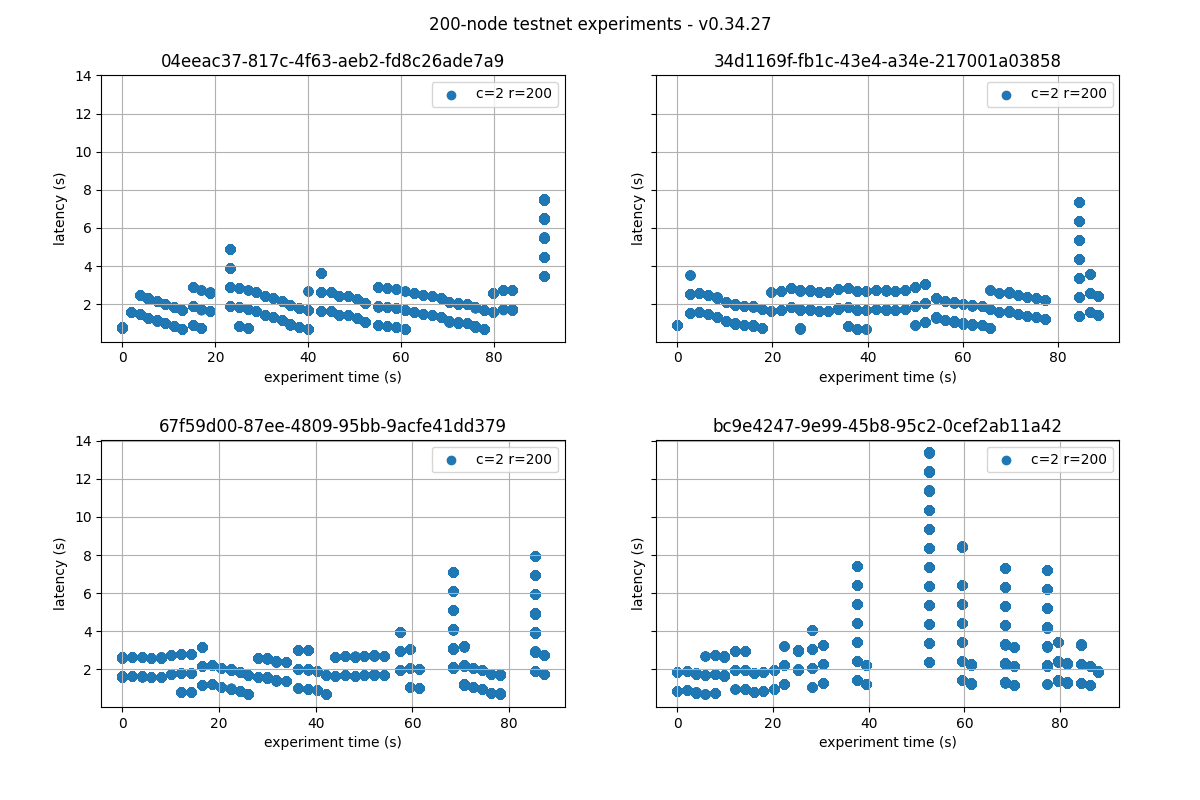 97 98 ### 1/3 Tendermint Core - 2/3 CometBFT 99 100  101 102 ### 2/3 Tendermint Core - 1/3 CometBFT 103 104  105 106 107 ## Prometheus Metrics 108 109 This section reports on the key Prometheus metrics extracted from the following experiments. 110 111 * Baseline results: `v0.34.x`, obtained in October 2022 and reported [here](TMCore-QA-34.md). 112 * CometBFT homogeneous network: experiment with UUID starting with `be8c`. 113 * Mixed network, 1/2 Tendermint Core `v0.34.26` and 1/2 running CometBFT: experiment with UUID starting with `04ee`. 114 * Mixed network, 1/3 Tendermint Core `v0.34.26` and 2/3 running CometBFT: experiment with UUID starting with `fc5e`. 115 * Mixed network, 2/3 Tendermint Core `v0.34.26` and 1/3 running CometBFT: experiment with UUID starting with `4759`. 116 117 We make explicit comparisons between the baseline and the homogenous setups, but refrain from 118 commenting on the mixed network experiment unless they show some exceptional results. 119 120 ### Mempool Size 121 122 For each reported experiment we show two graphs. 123 The first shows the evolution over time of the cumulative number of transactions 124 inside all full nodes' mempools at a given time. 125 126 The second one shows the evolution of the average over all full nodes. 127 128 #### Baseline 129 130  131 132  133 134 #### CometBFT Homogeneous network 135 136 The results for the homogeneous network and the baseline are similar in terms of outstanding transactions. 137 138  139 140 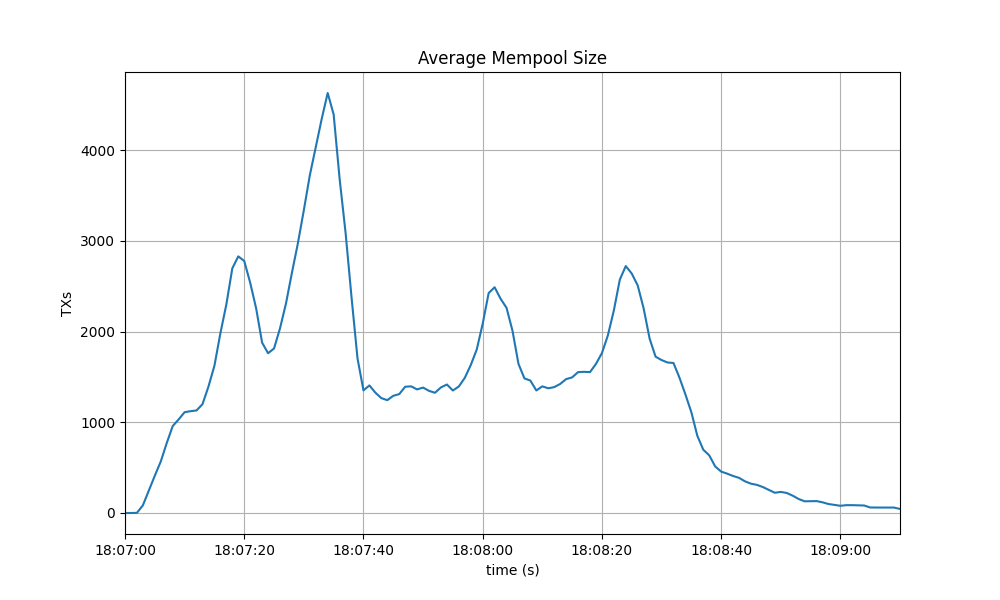 141 142 #### 1/2 Tendermint Core - 1/2 CometBFT 143 144 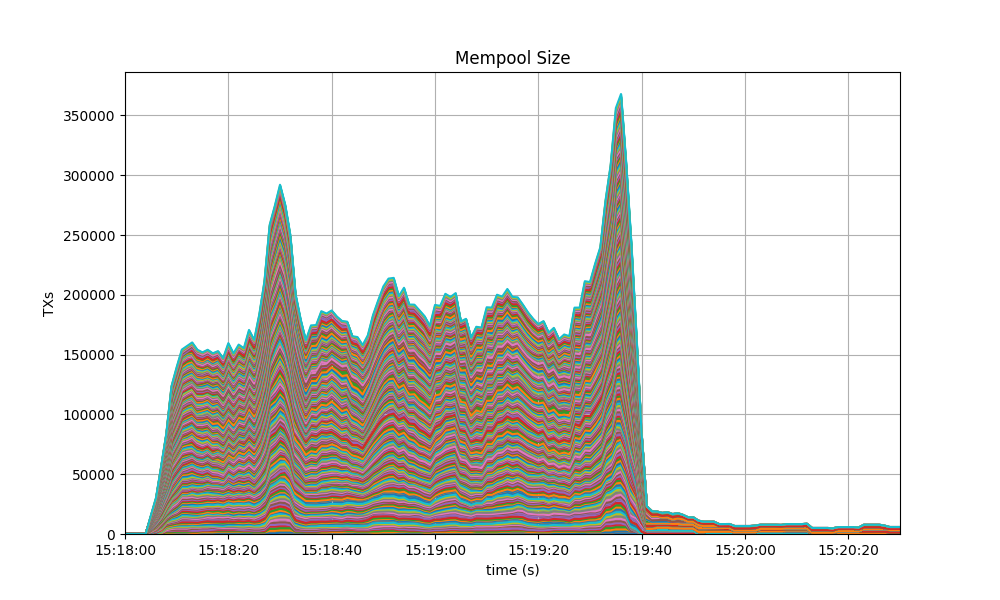 145 146  147 148 #### 1/3 Tendermint Core - 2/3 CometBFT 149 150  151 152  153 154 #### 2/3 Tendermint Core - 1/3 CometBFT 155 156  157 158  159 160 ### Consensus Rounds per Height 161 162 The following graphs show the rounds needed to complete each height and agree on a block. 163 164 A value of `0` shows that only one round was required (with id `0`), and a value of `1` shows that two rounds were required. 165 166 #### Baseline 167 We can see that round 1 is reached with a certain frequency. 168 169 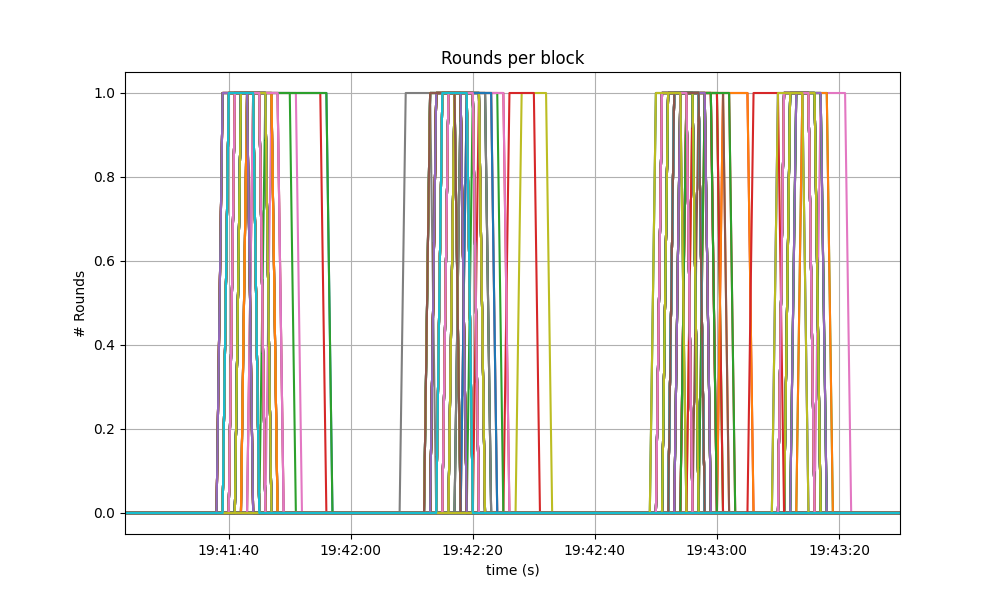 170 171 #### CometBFT Homogeneous network 172 173 Most heights finished in round 0, some nodes needed to advance to round 1 at various moments, 174 and a few nodes even needed to advance to round 2 at one point. 175 This coincides with the time at which we observed the biggest peak in mempool size 176 on the corresponding plot, shown above. 177 178  179 180 #### 1/2 Tendermint Core - 1/2 CometBFT 181 182  183 184 #### 1/3 Tendermint Core - 2/3 CometBFT 185 186  187 188 #### 2/3 Tendermint Core - 1/3 CometBFT 189 190  191 192 ### Peers 193 194 The following plots show how many peers a node had throughtout the experiment. 195 196 The thick red dashed line represents the moving average over a sliding window of 20 seconds. 197 198 #### Baseline 199 200 The following graph shows the that the number of peers was stable throughout the experiment. 201 Seed nodes typically have a higher number of peers. 202 The fact that non-seed nodes reach more than 50 peers is due to 203 [#9548](https://github.com/tendermint/tendermint/issues/9548). 204 205  206 207 #### CometBFT Homogeneous network 208 209 The results for the homogeneous network are very similar to the baseline. 210 The only difference being that the seed nodes seem to loose peers in the middle of the experiment. 211 However this cannot be attributed to the differences in the code, which are mainly rebranding. 212 213  214 215 #### 1/2 Tendermint Core - 1/2 CometBFT 216 217  218 219 #### 1/3 Tendermint Core - 2/3 CometBFT 220 221  222 223 #### 2/3 Tendermint Core - 1/3 CometBFT 224 225 As in the homogeneous case, there is some variation in the number of peers for some nodes. 226 These, however, do not affect the average. 227 228  229 230 ### Blocks Produced per Minute, Transactions Processed per Minute 231 232 The following plot show the rate of block production and the rate of transactions delivered, throughout the experiments. 233 234 In both graphs, rates are calculated over a sliding window of 20 seconds. 235 The thick red dashed line show the rates' moving averages. 236 237 #### Baseline 238 239 The average number of blocks/minute oscilate between 10 and 40. 240 241 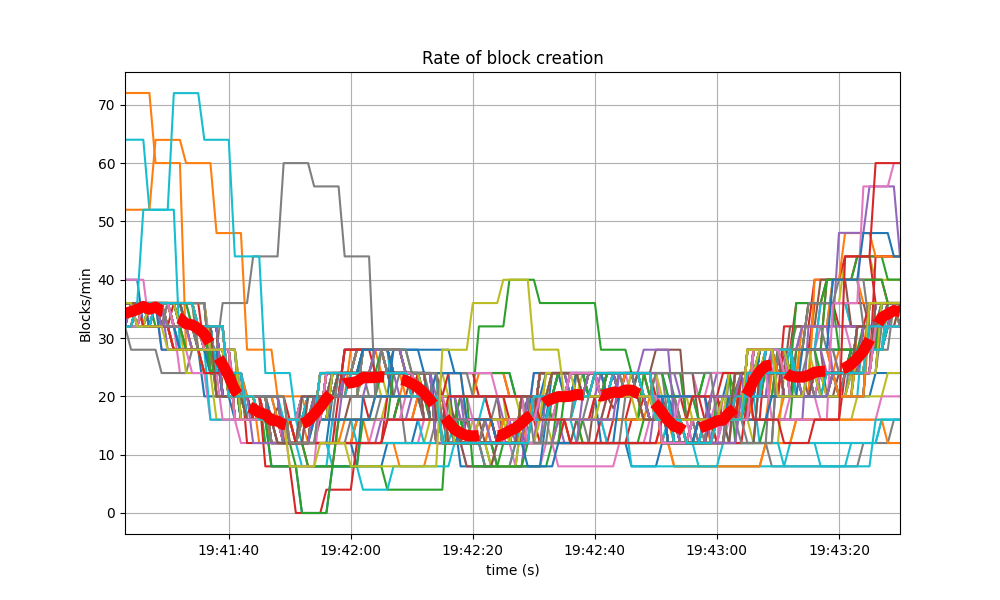 242 243 The number of transactions/minute tops around 30k. 244 245 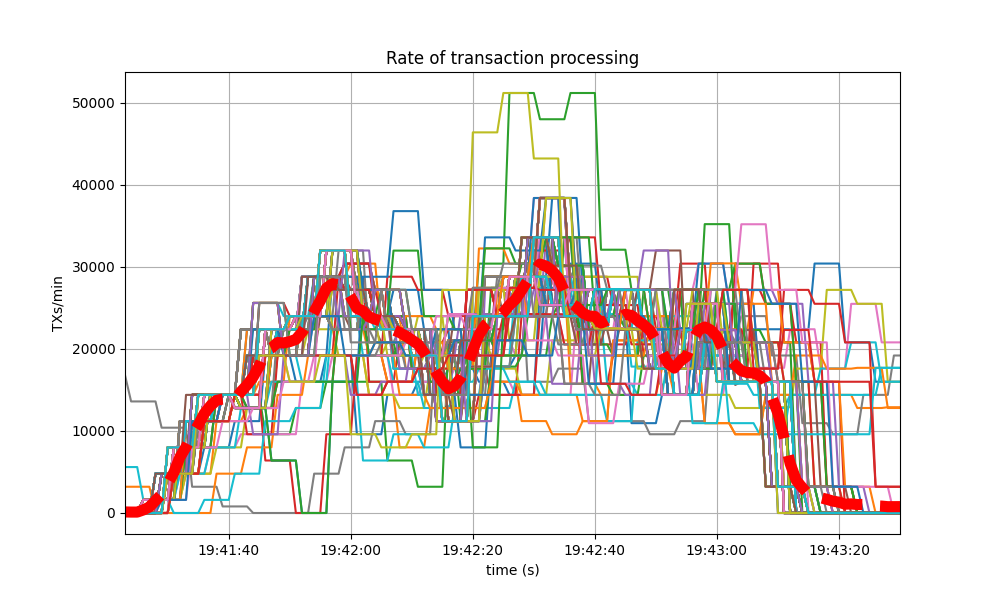 246 247 248 #### CometBFT Homogeneous network 249 250 The plot showing the block production rate shows that the rate oscillates around 20 blocks/minute, 251 mostly within the same range as the baseline. 252 253  254 255 The plot showing the transaction rate shows the rate stays around 20000 transactions per minute, 256 also topping around 30k. 257 258  259 260 #### 1/2 Tendermint Core - 1/2 CometBFT 261 262  263 264  265 266 #### 1/3 Tendermint Core - 2/3 CometBFT 267 268  269 270  271 272 #### 2/3 Tendermint Core - 1/3 CometBFT 273 274  275 276  277 278 ### Memory Resident Set Size 279 280 The following graphs show the Resident Set Size (RSS) of all monitored processes and the average value. 281 282 #### Baseline 283 284  285 286  287 288 #### CometBFT Homogeneous network 289 290 This is the plot for the homogeneous network, which is slightly more stable than the baseline over 291 the time of the experiment. 292 293  294 295 And this is the average plot. It oscillates around 560 MiB, which is noticeably lower than the baseline. 296 297 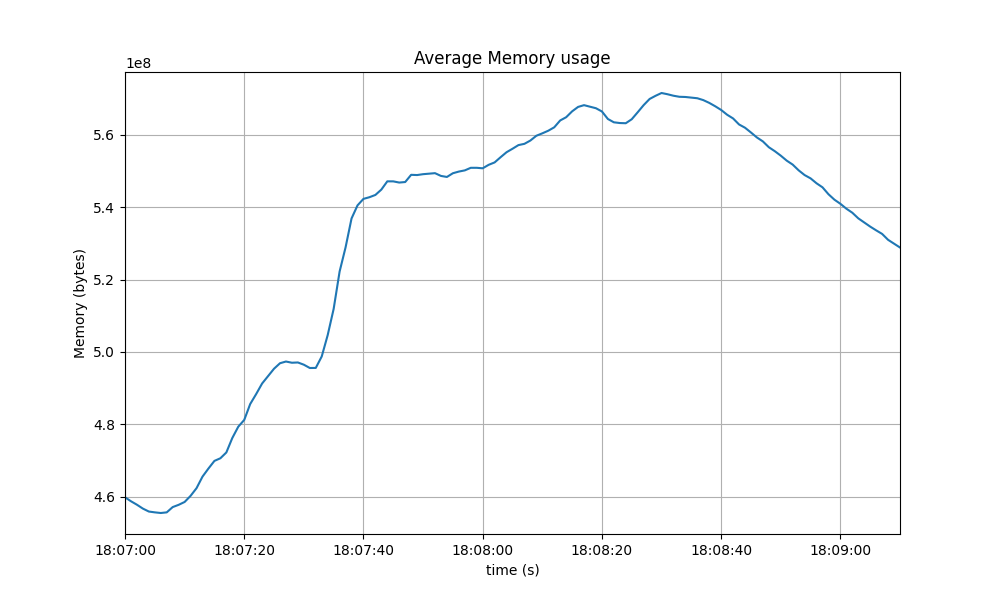 298 299 #### 1/2 Tendermint Core - 1/2 CometBFT 300 301  302 303  304 305 #### 1/3 Tendermint Core - 2/3 CometBFT 306 307  308 309  310 311 #### 2/3 Tendermint Core - 1/3 CometBFT 312 313  314 315  316 317 ### CPU utilization 318 319 The following graphs show the `load1` of nodes, as typically shown in the first line of the Unix `top` 320 command, and their average value. 321 322 #### Baseline 323 324  325 326 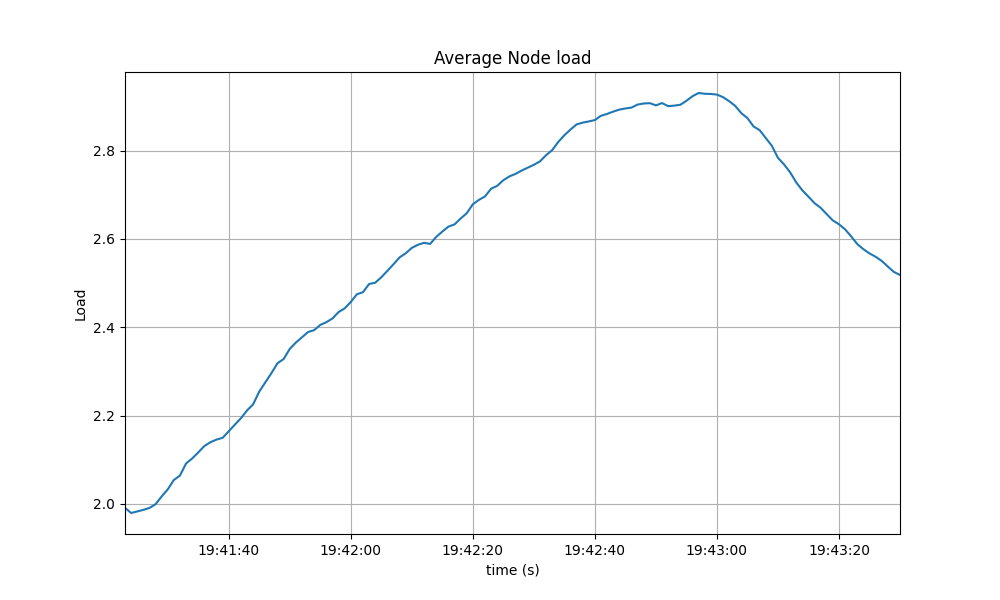 327 328 #### CometBFT Homogeneous network 329 330 The load in the homogenous network is, similarly to the baseline case, below 5 and, therefore, normal. 331 332  333 334 As expected, the average plot also looks similar. 335 336  337 338 #### 1/2 Tendermint Core - 1/2 CometBFT 339 340  341 342  343 344 #### 1/3 Tendermint Core - 2/3 CometBFT 345 346  347 348  349 350 #### 2/3 Tendermint Core - 1/3 CometBFT 351 352  353 354  355 356 ## Test Results 357 358 The comparison of the baseline results and the homogeneous case show that both scenarios had similar numbers and are therefore equivalent. 359 360 The mixed nodes cases show that networks operate normally with a mix of compatible Tendermint Core and CometBFT versions. 361 Although not the main goal, a comparison of metric numbers with the homogenous case and the baseline scenarios show similar results and therefore we can conclude that mixing compatible Tendermint Core and CometBFT introduces not performance degradation. 362 363 A conclusion of these tests is shown in the following table, along with the commit versions used in the experiments. 364 365 | Scenario | Date | Version | Result | 366 |--|--|--|--| 367 |CometBFT Homogeneous network | 2023-02-08 | 3b783434f26b0e87994e6a77c5411927aad9ce3f | Pass 368 |1/2 Tendermint Core <br> 1/2 CometBFT | 2023-02-14 | CometBFT: 3b783434f26b0e87994e6a77c5411927aad9ce3f <br>Tendermint Core: 66c2cb63416e66bff08e11f9088e21a0ed142790 | Pass| 369 |1/3 Tendermint Core <br> 2/3 CometBFT | 2023-02-08 | CometBFT: 3b783434f26b0e87994e6a77c5411927aad9ce3f <br>Tendermint Core: 66c2cb63416e66bff08e11f9088e21a0ed142790 | Pass| 370 |2/3 Tendermint Core <br> 1/3 CometBFT | 2023-02-08 | CometBFT: 3b783434f26b0e87994e6a77c5411927aad9ce3f <br>Tendermint Core: 66c2cb63416e66bff08e11f9088e21a0ed142790 | Pass |